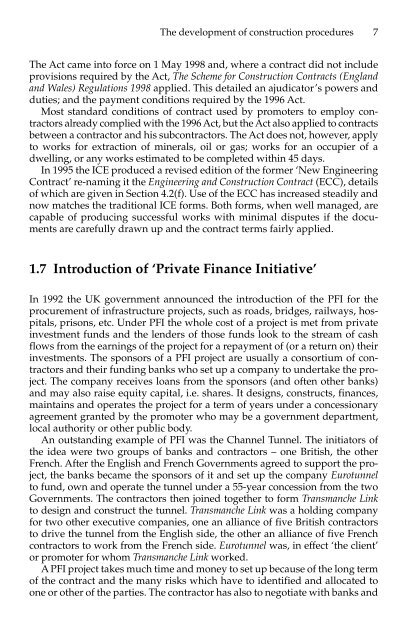Civil Engineering Project Management (4th Edition)
Create successful ePaper yourself
Turn your PDF publications into a flip-book with our unique Google optimized e-Paper software.
The development of construction procedures 7<br />
The Act came into force on 1 May 1998 and, where a contract did not include<br />
provisions required by the Act, The Scheme for Construction Contracts (England<br />
and Wales) Regulations 1998 applied. This detailed an ajudicator’s powers and<br />
duties; and the payment conditions required by the 1996 Act.<br />
Most standard conditions of contract used by promoters to employ contractors<br />
already complied with the 1996 Act, but the Act also applied to contracts<br />
between a contractor and his subcontractors. The Act does not, however, apply<br />
to works for extraction of minerals, oil or gas; works for an occupier of a<br />
dwelling, or any works estimated to be completed within 45 days.<br />
In 1995 the ICE produced a revised edition of the former ‘New <strong>Engineering</strong><br />
Contract’ re-naming it the <strong>Engineering</strong> and Construction Contract (ECC), details<br />
of which are given in Section 4.2(f). Use of the ECC has increased steadily and<br />
now matches the traditional ICE forms. Both forms, when well managed, are<br />
capable of producing successful works with minimal disputes if the documents<br />
are carefully drawn up and the contract terms fairly applied.<br />
1.7 Introduction of ‘Private Finance Initiative’<br />
In 1992 the UK government announced the introduction of the PFI for the<br />
procurement of infrastructure projects, such as roads, bridges, railways, hospitals,<br />
prisons, etc. Under PFI the whole cost of a project is met from private<br />
investment funds and the lenders of those funds look to the stream of cash<br />
flows from the earnings of the project for a repayment of (or a return on) their<br />
investments. The sponsors of a PFI project are usually a consortium of contractors<br />
and their funding banks who set up a company to undertake the project.<br />
The company receives loans from the sponsors (and often other banks)<br />
and may also raise equity capital, i.e. shares. It designs, constructs, finances,<br />
maintains and operates the project for a term of years under a concessionary<br />
agreement granted by the promoter who may be a government department,<br />
local authority or other public body.<br />
An outstanding example of PFI was the Channel Tunnel. The initiators of<br />
the idea were two groups of banks and contractors – one British, the other<br />
French. After the English and French Governments agreed to support the project,<br />
the banks became the sponsors of it and set up the company Eurotunnel<br />
to fund, own and operate the tunnel under a 55-year concession from the two<br />
Governments. The contractors then joined together to form Transmanche Link<br />
to design and construct the tunnel. Transmanche Link was a holding company<br />
for two other executive companies, one an alliance of five British contractors<br />
to drive the tunnel from the English side, the other an alliance of five French<br />
contractors to work from the French side. Eurotunnel was, in effect ‘the client’<br />
or promoter for whom Transmanche Link worked.<br />
A PFI project takes much time and money to set up because of the long term<br />
of the contract and the many risks which have to identified and allocated to<br />
one or other of the parties. The contractor has also to negotiate with banks and


















